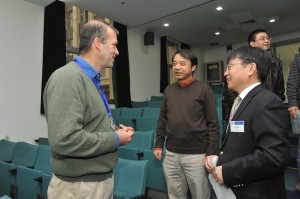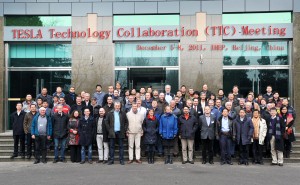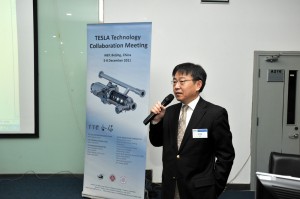TESLA, which stands for TeV-Energy Superconducting Linear Accelerator, is the name of a former planned collider using an accelerating technology closely linked with the ILC. To some extent, TESLA can be said to be the predecessor of ILC technology. As time has gone by, TESLA technology has expanded its meaning to include superconducting radiofrequency (SCRF) advances and related accelerator studies across a broad diversity of scientific applications. Last month, from 5 to 8 December, the biannual TESLA Technology Collaboration (TTC) meeting, hosted by the Institute of High Energy Physics (IHEP), Chinese Academy of Sciences together with Peking University and Tsinghua University, was held at IHEP in Beijing. About 100 experts around the world in accelerator field participated.
“The mission of the TTC meeting is to keep open and provide a bridge for communication and sharing of ideas, developments, and testing across associated projects,” said Jie Gao, chair of the Asian Linear Collider Steering Committee and chair of local organising committee. IHEP Director Yifang Wang welcomed everyone to the conference and gave a brief introduction of the current projects IHEP has led, such as the China Spallation Neutron Source and the Daya Bay Neutrino Experiment. “We will actively participate in the SCRF technology fields, especially those related to ILC research,” he said.
The TTC, which originated at DESY in 2000, has met for more than 20 sessions. This meeting is the first that was held in China, providing a good platform for China’s participation in TESLA technology-related research and cooperation. Right now, TTC includes three Chinese institutes: IHEP, Peking University and Tsinghua University. As part of this cooperation, the Chinese Academy of Sciences launched design and R&D work for establishing SCRF accelerator-driven systems in China.

Olivier Napoly (left) talks with Yifang Wang (middle) and Jie Gao (right) at the TTC meeting. Image: Jie Liu, IHEP
“This is a very important step to enrich the range of applications envisaged for SCRF technology, and it reinforces the influence of the TTC,” said Olivier Napoly, TTC chair. Peking University also launched its own TTC-related programme, the construction of an electron recovery linac prototype on its site, joining other TTC laboratories, such as Cornell University in the US, the Helmholtz Centre Berlin for Materials and Energy in Germany and the Science and Technology Facilities Council in the UK, who are developing similar projects.
More than 50 talks were given during the meeting. “Several agreements were reached during the meeting,” said Olivier. “One such agreement includes an exchange of descriptions of the cryomodule integration steps among the concerned TTC members in order to cross-scrutinise their procedures and to detect eventual mistakes that could explain the observed degradation of cavity gradient after cryomodule assembly. We also updated information about the realisation, the cost and the benefits of magnetic shielding, as well as about the property of the different materials used at cold temperatures at various labs.”
The TTC meeting may have a beneficial impact on the ILC design, cost optimisation and industrialisation plan. But the TTC and the ILC were further linked by another conference, the ILC-GDE SCRF meeting, which took place at IHEP immediately following the TTC conference.
“This time, a combination of several things, such as the venue, the TTC participants and the TTC agenda, made the ILC-GDE SCRF meeting effective and interesting,” said Marc Ross, GDE project manager. “During the TTC meeting, we discussed data related to cavity performance changes following cryomodule assembly. At the following ILC-GDE SCRF meeting, with this quite fresh in everyone’s mind and with the experts in the room, we were able to collect opinions on how the problem might be summarised and quantified for the ILC technical design.”
GDE Project Manager Akira Yamamoto summed up the meeting’s success.
“We have been very successful in discussing the technology and we were receptive to various pieces of advice. We also seriously discussed which technology variation to be adopted. Soon we will have to choose the best cost-effective choice that satisfies ILC requirements,” he said.
The ILC-GDE SCRF meeting prepared scientists for the upcoming SCRF Baseline Technical Review to be held at KEK from 19 to 20 January.



Recent Comments